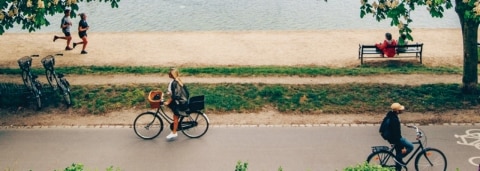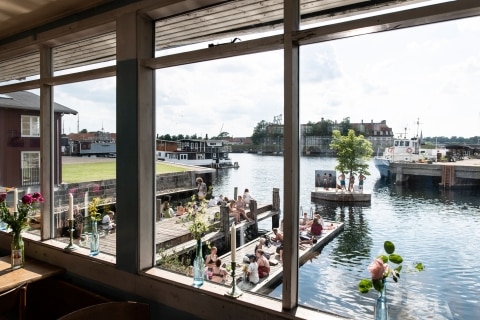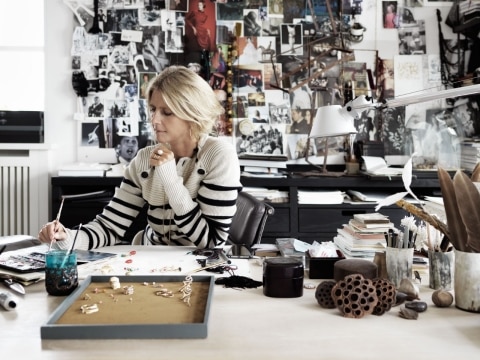Eat Your Way Through Copenhagen
In less than 10 years, Copenhagen went from being a non-starter on the food scene to luring gourmands for its experimental, edgy and influential dining. But where do the locals eat in the capital of haute cuisine?
When I first moved to Copenhagen, not quite a decade ago, it sometimes felt like there was nowhere to eat. Of course, there were excellent high-end restaurants; Noma had launched roughly 10 years earlier and, with its Nordic cooking, had literally put the Danish capital on the map for the kind of deep-pocketed food-lover who travels the globe to dine in the most acclaimed places. Unsurprisingly, the announcement in January of its closure, scheduled for 2024, made headlines.
There were also plenty of great spots serving smørrebrød – the open-faced sandwiches that are Denmark’s proudest (some would say sole) contribution to world cuisine. But for anything else? A pizzeria serving serious pies, instead of the cardboard crusts that takeaway joints dispensed? A kitchen turning out something decently spicy, whether that’s enchiladas or dan dan noodles? The kind of neighbourhood bistro you could drop into on a Tuesday night and be certain of a good meal? There was a reason why Danes only went to restaurants for special occasions.
Turns out it was only a matter of time. When the streams of ambitious young chefs, servers and sommeliers who flocked to Copenhagen to work at Noma and its ilk eventually started opening their own eateries, they initially clung pretty closely to the upscale Nordic model – all foraged plants, acidic flavours and expensively sleek timber furniture.
But gradually, their vision expanded to include other types of cuisine and ways of serving them and that transition, in turn, drew yet more talented young chefs and somms. Today, the city’s restaurant scene encompasses exciting versions of everything from Caribbean seafood to burgers to tacos to kaiseki. And Danes themselves, delighting in the newfound abundance, have even learnt how to eat
out on a Tuesday night.
So, while some visitors come to do a World’s 50 Best Restaurants crawl (in 2022, Copenhagen took out numbers one, 18 and 38 with fine-diners Geranium, Alchemist and Jordnaer, respectively), here’s what the locals are actually eating – and where.

Image credit: Martin Kaufmann. Pictured: Schønnemann restaurant
Smørrebrød
1/10Danes take their smørrebrød very seriously. Eaten primarily at lunch, open-faced sandwiches come in a bewildering array of variations but are guided by unspoken rules on everything from the type of bread (short answer: rye) to the order in which the pieces should be consumed. One of the best places to get the full experience is centrally located Schønnemann, where the 19th-century rooms are cosily cluttered, the waiters inordinately cheerful and the multi-page menu features well-made classics such as The Virgin Midnight Snack (a creamy chicken salad studded with bacon and topped with crisp curls of fried carrot) or more newfangled innovations, including smoked eel on fluffy scrambled egg. The traditional pairing is aquavit (considered the national spirit), which comes in its own array of flavours and styles and is served in sizes that range from “embarrassing” (small) to “sensible” (large).
Image credit: Martin Kaufmann. Pictured: Emil Glaser at his bakery, Juno
Cardamom bun
2/10The Danish as we know it was actually introduced by a bunch of strike-breaking Viennese bakers (it’s a long story) but the range of pastries here, from flaky spandauers that ooze custard to marzipan-wrapped træstammer (“tree trunks”) that enclose boozy chocolate crumbs, nevertheless attests to a country that loves its cake. Yet for all the buttery diversity, it took former Noma chef Emil Glaser to add the homey cardamom bun, from his native Sweden, to the roster of treats. These days, the aromatic pastries can be found all over the city but the ones Glaser makes at his bakery, Juno, at Århusgade 48 in the Østerbro neighbourhood – impossibly soft, flecked with spice and emerging from the oven with crunchy caramelised bits from where the prodigious amounts of butter and sugar melted into the pan – remain the best.
Image credit: Martin Kaufmann. Pictured: founder John Michael Jensen and his John’s Hotdog Deli stand
The hot dog
3/10No, really. Denmark’s original – and for a long time, only – street food, hot dogs remain a favourite lunch or postclubbing snack and one of the few things that the locals will actually eat in public when they’re by themselves. John's Hotdog Deli (Bernstorffsgade 18), often touted as the city's finest, was founded in 2007 and still keeps a stand outside Central Station, making it ideal for takeaway. Like far more highbrow places, its menu, believe it or not, often has a seasonal section; in winter, you can get a sausage made from game and topped with pickled red cabbage.
Image credit: Martin Kaufmann. Pictured: Cockles from Goldfinch restaurant
Asian cuisine
4/10Copenhagen is only a couple of decades late to the trend but the past year or two has brought a veritable explosion in restaurants turning out credible yet inventive takes on different Asian cuisines. One of the newest – and most exciting – comes from the hands of an Aussie, Will King-Smith, who spent many years cooking in some of the city’s more renowned places, including top-ranked Geranium, before ceding to his first love: the Cantonese cuisine that was a staple of his earlier life in Sydney. With its spacious, low-lit dining room populated by curved booths, Goldfinch, which opened in the central Kongens Nytorv area late in 2022, looks unlike any other eatery in the city and its menu is as sophisticated as its décor. Here, the crunchy, sesame-encrusted toast is made with sweet scallops instead of prawns, the plump steamed cockles are invigorated with citrus and chilli paste and the glaze on the juicy char sui carries an evocatively floral hint of rose. Delicate dumplings, fiery noodles and a luscious “Hong Kong-style French toast” round out the offerings.
Image credit: Martin Kaufmann. Pictured: Baker Erik Galst at Galst Bageri
Bread
5/10Copenhagen has the best bread in the world – it’s a bold claim but I’m standing by it. The number of bakeries turning out chewy sourdough and cocoa-coloured bricks of malty Danish rye exploded during the pandemic but perhaps the most idiosyncratic is Galst Bageri, which got its start when then-amateur baker Erik Galst took over the kitchen of a local football club. His delectable loaves proved so popular that he was able to open a permanent version last year in the Østerbro neighbourhood.
Image credit: Martin Kaufmann. Pictured: Surt pizzeria
Pizza
6/10All that attention to sourdough has also translated into some great pizza. At Surt in the Carlsberg district, pizzaiolo Giuseppe Oliva, who comes from a family of bakers, ferments a dough made from ancient grains until it has a noticeable zing of acidity. Then he tops it with gorgeous ingredients and bakes it in the woodfired oven that dominates the open kitchen until it gets those nicely blackened bubbles that signal a superior pizza. Standouts here include the organic pork sausage and buffalo mozzarella – their flavours jolted with chilli and sage – and the seemingly simple but intensely savoury Rianata, popping with onion and anchovy.
Image credit: Martin Kaufmann. Pictured: Auren’s Deli
The deli
7/10After working at the acclaimed Amass, Henry Stevens and Pernille Rosenbæk opened Auren’s Deli last year and quickly made it the neighbourhood shop that Frederiksberg hadn’t known it needed. Along with its selection of French cheeses, local milk and yoghurt from a regenerative dairy, plus imported charcuterie, the beautifully designed shop sells fresh fruit and vegetables – many of them grown on the owners’ farm located outside Copenhagen. As befits a deli, the simple but ever changing roster of lunchtime sandwiches – a cheddar and chutney or ham and ‘nduja with pickled vegetables – are the stars.
Image credit: Martin Kaufmann. Pictured: The interior of Ved Stranden 10 and a selection of its wine
Natural wine
8/10Copenhagen is a hub for natural wines. In fact, after Paris and Tokyo, it may be the natural wine city – yet another debt it owes to Noma, which set the pace by switching its wine list over to the funkier stuff early in its history. Yet even with today’s wide range of venues, there’s still no better place than the OG wine bar, Ved Stranden 10. Situated across the canal from Christiansborg, the parliament building whose spire will be familiar to anyone who has watched Borgen, it remains a remarkably inviting place at every level, from the warm interior furnished in an eclectic collection of Danish Modern to the by-the-glass selection that’s heavy on delicious Austrian wines. The service leans towards the intuitive – instead of a wine list, the waitstaff ask about your preferences then they choose accordingly.
Image credit: Martin Kaufmann. Pictured: Grimal
The bistro
9/10Located on a lively corner in Vesterbro, Grimal is the kind of place you could happily eat at once a week. The menu isn’t huge – usually just three or four starters, the same number of mains and a handful of snacks that play nice with aperitifs (the proper Scotch egg is especially popular). But each of the one-step-above-familiar dishes, like a tangy tartare studded with cornichons or a plush piece of haddock set atop silky leeks and bathed in creamy sauce, satisfies the soul. And the friendly staff make every diner feel like a regular.
Up Next
10/10









